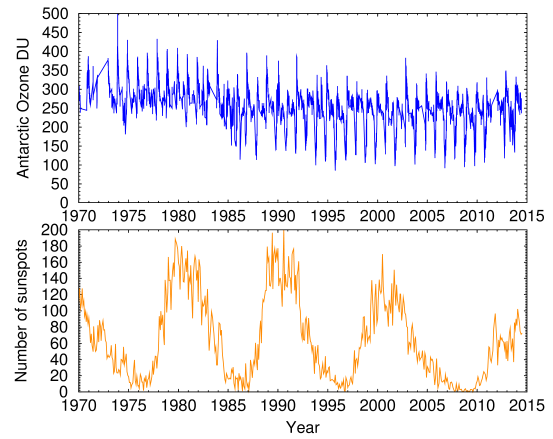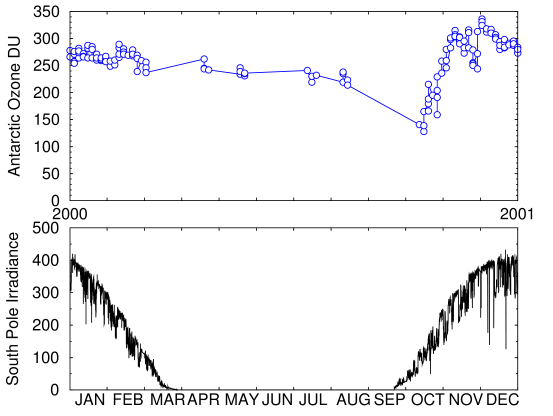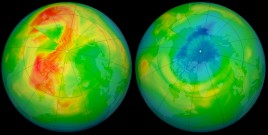Atmospheric Chemistry Notes
Rethinking Ozone
 Fig. 1. Molecular model of ozone. Ozone in liquid form has a dark blue color.
Fig. 1. Molecular model of ozone. Ozone in liquid form has a dark blue color.
For a lot of us, ozone means the ozone layer, which means the ozone hole that we were told would end all life on the planet unless we stopped emitting chlorofluorocarbons (CFCs). Dupont agreed to stop manufacturing them, and almost by magic, the ozone hole disappeared from the public consciousness—even though the ozone hole was still there, and even environmentalists agreed that if anything had changed it was far too soon to have been in response to anything we had done.
The real reason was the environmentalists had moved on to their next big project: global warming. By now most of us are bored to death about global warming, and perhaps even more so about the ozone hole. Before the ozone hole there was acid rain, and then alar, PCBs, pesticides, and so on. All imminent disasters that magically went away.
We are now in a position, nearly thirty years after CFC production was stopped, to ask: has the Montreal Protocol actually done anything? Or were we chasing after phantoms? The ozone hole has features more consistent with natural variation than with a gradual reduction by CFCs. New data have raised even more doubts about the CFC hypothesis.
The full version of this article contains more background on the interesting science of ozone in the stratosphere.
Ozone and CFCs
Here's the bottom line: CFCs can reduce ozone levels. But many other factors, including temperature, wind, water, cosmic rays, and ionized particles from the sun also play a large role in determining ozone levels. Computer models of reaction kinetics predict ozone loss. Other models are needed to predict the rate of stratospheric transport. Chemical kinetics equations are very robust, even for free radical reactions, provided that you know all the side reactions and all the rate constants precisely. Unfortunately, this was recently found not to be the case. And, of course, you can't model a reaction you don't know about. Even one such reaction could easily invalidate the model. As I argued here, models are useful for generating and testing hypotheses, but cannot be used to draw conclusions about the real world.
The main thing that ties CFCs to the ozone hole is the computer models. As I will show below, these models cannot account for the shape of the change, and they did not predict the Arctic ozone hole or its disappearance. Precautionary Principle The Precautionary Principle states: “We don't know if this is what causes the problem, or whether the problem is even real, but we can't take any chances, so we'll ban it.”
Banning CFCs was an example of the so-called precautionary principle, and in this case the economic interests of Dupont coincided with the interests of the environmentalists, so there was no serious opposition. It's generally regarded as a success story. But the subject is highly politicized, and much of the information on the subject, especially on the Internet, is based on politics instead of cautious science. To your refrigerator repairman, the whole episode probably smells like Danegeld.
Historical Data
Let's look at the historical data (Fig. 1). The ozone hole is the bottom of those sharp downward-pointing peaks that occur at one-year intervals. Rather than a gradual change as you might expect, these peaks suddenly jump from about 220 to around 120 beginning around 1985. This remains constant almost to the present. This sudden jump is a striking example of non-linearity and it is hard to explain by the gradual increase of an environmental pollutant. There is no doubt that CFCs can react with, and (at least in computer simulations) deplete ozone. But the amazing non-linear effect shown here cannot be easily explained by a chemical reaction.

Fig. 1. Top curve: Antarctic ozone historical data 1970-2014 (Data Source: NOAA)
Bottom curve: International Sunspot Numbers. (Data from the Solar Influences Data Analysis Center in Belgium.)
Computer models can explain some of this. But as a friend of mine once said, with a computer model you can fit your aunt to your ankle. To me this curve is a clear example of something called a state transition in an attractor. An attractor is a mathematical function that describes how natural phenomena can remain stable for a long time, and then suddenly jump to a completely different state, remain there for a while, and then jump back, seemingly at random. Chris Lucas has a good description of attractors.
Whatever is causing this pattern, whether it's an attractor or a hitherto unknown chemical reaction, there's a big piece of the puzzle missing, and many Nature papers waiting to be written.
Note that this graph is plotted from ground-based Dobson data, not the NASA NIMBUS-7 satellite data which, embarrassingly, had been corrupted by a computer program that automatically threw out any data point below a certain value. NASA scrambled to add the missing data points to their data set after their mistake was discovered, but it was too late and most people still use the ground data exclusively.
The sunspot cycle is plotted in the lower curve. Sunspots are known to affect ozone levels, with a 2-3 year lag between sunspot and ozone.
The next graph (Fig. 2) shows how the measured ozone level changes over the course of one year. Ozone decreases at roughly the same time, or possibly slightly before, the sunlight begins to return in the southern spring. Illumination at the South Pole is shown in the black curve. Unfortunately, few ozone measurements have ever been taken in August and almost none in September. Those missing data points contain critical information that we would need to be confident about whether the ozone starts to decrease before or after the light returns.

Fig. 2. Top curve: Antarctic ozone historical data for 2000 (Data Source: NOAA)
Bottom curve: Average daily insolation at South Pole in 2000 from NOAA's ESRL Global Monitoring Division. (Data Source: NOAA)
The reason that's important is that ozone is not produced during the polar winter, because formation of ozone requires UV light. But the ozone does not begin to drop until winter is almost over. The reason for this is said to be that the reactions are what chemists call free-radical reactions. Free-radical reactions don't start spontaneously. They need an “initiator” which kick-starts the reaction chain. The models indicated that UV light is not only necessary to create ozone, but also to destroy it. The thinking was that chlorine, produced during the previous year, accumulates in polar stratospheric clouds during the winter, and then starts chewing up ozone when light hits it in the springtime. Some other researchers have claimed that cosmic rays, not UV light, provides these initiators. But cosmic rays should reach the atmosphere throughout the winter, so the cosmic ray theory has met with resistance.
Arctic ozone hole
 Fig. 3. Ozone hole over North Pole in 2011 (Source: NASA/Goddard).
In 2011 the ozone over the Arctic suddenly decreased by about 22%, creating what
was called the Arctic ozone hole (Fig. 3). The ozone levels were the lowest over
the Arctic ever recorded—24 years after Montreal. This was about half as much
as the loss in the Antarctic, but it was unexpected. It also happened while the hole
over Antarctica was commonly and erroneously believed to be getting smaller. NASA
fired up their computer models and attributed the hole partly to CFCs and partly to
a natural delay of final spring warming, which reduced transport into the polar
vortex. The Arctic hole has since disappeared (after lots of hand-wringing in
the popular press). But here's the point: if an eddy
can happen for one year, it can also happen for ten years. And that means we
have to rely on models to tell us how much of the hole over Antarctica is
caused by CFCs and how much is natural. Which is a polite way of saying that
all we really have is a hypothesis.
In other words, we do not really know whether the hole is caused by CFCs, natural
variation, or something else that we have not yet discovered.
Fig. 3. Ozone hole over North Pole in 2011 (Source: NASA/Goddard).
In 2011 the ozone over the Arctic suddenly decreased by about 22%, creating what
was called the Arctic ozone hole (Fig. 3). The ozone levels were the lowest over
the Arctic ever recorded—24 years after Montreal. This was about half as much
as the loss in the Antarctic, but it was unexpected. It also happened while the hole
over Antarctica was commonly and erroneously believed to be getting smaller. NASA
fired up their computer models and attributed the hole partly to CFCs and partly to
a natural delay of final spring warming, which reduced transport into the polar
vortex. The Arctic hole has since disappeared (after lots of hand-wringing in
the popular press). But here's the point: if an eddy
can happen for one year, it can also happen for ten years. And that means we
have to rely on models to tell us how much of the hole over Antarctica is
caused by CFCs and how much is natural. Which is a polite way of saying that
all we really have is a hypothesis.
In other words, we do not really know whether the hole is caused by CFCs, natural
variation, or something else that we have not yet discovered.
CFCs and Ozone
Stratospheric ozone between 35-45 km has basically remained roughly constant since about 1985, which is two years before the Montreal Protocol was adopted. The lack of continuing decline is puzzling, because the mean surface mixing ratios of most CFCs have decreased only slightly, if at all, between 1990 and 2010. Some have increased dramatically. Some articles show a graph of ozone that seems to be bending up slightly in recent years, but the error bars are large. To the skeptical eye it looks like wishful thinking. We would like to believe we fixed the problem. But if ozone starts declining again, there will be many red faces.
| Molecule | Lifetime | Direction | 1990 ppt | 2010 ppt (parts per trillion) |
|---|---|---|---|---|
| CFC-11 | 45 yr | ↓ | 267 | 240 |
| CFC-12 | 100 yr | ↑ | 480 | 540 |
| HCFC-22 | 12 yr | ↑ | 90 | 190 |
| Methyl chloroform | 5 yr | ↓ | 130 | 10 |
| Methyl bromide | 0.7 yr | ↓ | 9 | 7.8 |
Some molecules, like chloroform, methyl bromide and methyl iodide, don't last long enough to make it up to the stratosphere before being destroyed or washed out. So they probably never contributed much to ozone depletion. They might make it up there in localized areas, but there is still a lot of uncertainty about that.
Conclusion
Has the Montreal Protocol prevented the ozone hole from worsening, or is it just a convenient fiction? It's too early to say. Unfortunately, it has also become something of a sacred cow. We can no longer think about ozone without realizing how politics has distorted our opinions of it. It's a shame that we put so much focus on the dangers of chemicals instead of on their fascinating properties, because the greatest discoveries are always made not when the research is channeled into public service, but when a natural phenomenon is studied for its own sake.
Politicizing science hurts innovation, because it makes it much harder for scientists to abandon the reigning paradigm. Mainly this is because of the human need to believe that we really do understand the problem. Psychologists call this cognitive closure, and it's always a risk in science, but the pressure to reinforce a public narrative can only raise that risk. A perfect example was the quote from a NASA scientist saying the Arctic ozone hole wouldn't have been as severe if it happened thirty years from now, because there will be less chlorine in the atmosphere. Maybe she's right, but I wouldn't be surprised if she's not. A big piece of the puzzle is still missing.
